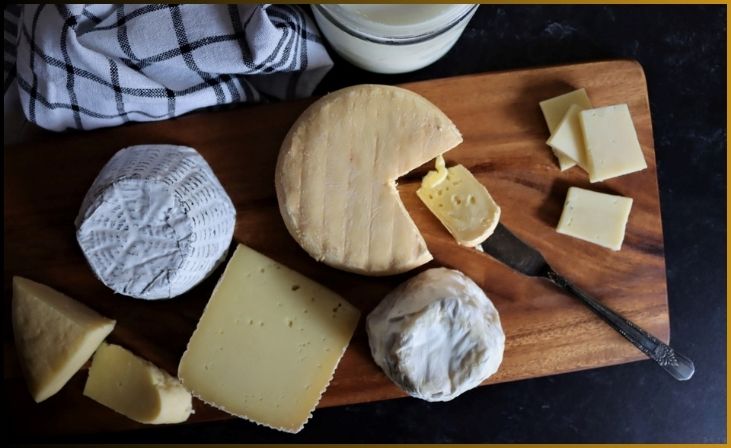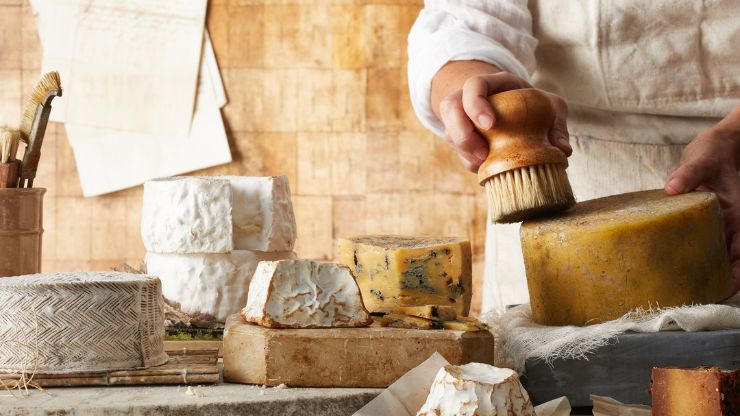Heidi is one of the favorite books of my childhood. Reading about how Alm’s Uncle took the milk from his goats and made cheese inspired me, even at 10 years old. The nourishment of that raw milk cheese not only made Heidi flourish but restored the crippled Clara.
Today, however, cheese is considered a corrupted food. Diet books tell you to avoid it. Commercials tell you it will keep adult children from growing up. It even gives you zits. What changed?
Cheese making was divorced from our bio-diverse kitchens and became a product of sterile laboratories. Raw milk became a fearsome thing, along with germs and childhood diseases. And in our fear, we forgot how to keep fresh milk clean and make cheese the way our grandmothers and Alm Uncle did.
David Asher, in The Art of Natural Cheesemaking, Using Traditional, Non-Industrial Methods to Make the World’s Best Cheese, is restoring the gift of our ancestors by reminding us what we knew all along. Raw milk is healthy, when it’s handled properly. And raw milk cheeses can be made at home, just like Alm Uncle did.
In fact, Asher doesn’t even sell the cheese he makes. He can’t. It’s illegal. So he spends his free time teaching others how to make this beautiful, wholesome food the way our grandmothers did, in the kitchen.
Table of Contents
ToggleThe Art of Natural Cheesemaking Book Review
Most cheese-making books will tell you that you need to have a home dairy sterile like a laboratory to be successful in making cheese. I own several books like that. They demand specific laboratory-made cheese cultures and genetically modified rennetes. These cultures and rennet travel across the globe to find their way to my kitchen. The recipes start with 4 to 25 gallons of milk. I get about 2 gallons from milking 4 goats at the peak of their lactation. Most often, though, I’m dealing with only 3 or 4 quarts of milk a day. A little intimidating, isn’t it? This is not sustainable.
The Art of Natural Cheesemaking offers a fresh look at this ancient art. It introduces modern homesteaders to wild cheese cultures, indigenous to our local environments. Blue cheese Penicillium roqueforti grown on sourdough bread, Brevibacterium linens developed in brine for Camembert and Brie, and kefir cultures grown in raw milk replace the industrialized cultures and ripening agents we are told we need to make good cheese.
Quick Review: Nourishing Traditions Book Review
How often have you put off making cheese because you didn’t have any mesophilic or thermophilic cheese culture in an envelope in your fridge? I have. Or you bought a thermophilic starter for mozzarella cheese and a Bulgarian yogurt culture for yogurt making. Guilty, again. This book is going to save you money.
Don't just scroll, subscribe!
BuzzTrail's unique web-stories are the cure for boredom you've been waiting for.
The book suggests that we bring cheese-making back to the farmstead kitchen. We don’t have to buy a unique culture for each kind of cheese that we want to make anymore. In fact, we never did need to. We were duped. Simply by changing the conditions of the cheese making, we can control the culture that develops in the cheese.
His secret is kefir. Kefir grains contain complementary thermophilic and mesophilic cultures of yeast and dozens of other symbiotic bacteria. Each species plays a different role in the cheesy community.
Kefir may be the perfect cheesemaking culture. It’s a biodiverse culture that is very easy to care for, simple to use, and nearly impossible to contaminate. The process of keeping kefir and using it for making cheese is similar to that for keeping sourdough starter for baking bread.”

Kefir not only contains the right cultures for both thermophilic and mesophilic cheese making, it is also a source of bacteria for aging cheeses because it contains the bacteria that “feed on the products left behind by lactic acid bacteria. Kefir culture can therefore provide successions of ripening bacteria to any aged cheese.” Genius! In fact, the book shows us how to use kefir culture to make thick yogurt, crème fraiche, sour cream, and even cultured butter.
There are clear directions to make a cheese cave for ripening aged cheeses, a cheese press out of materials you probably have on hand, and how to obtain natural rennet on the farm. The only culture you’ll need to make the cheeses in this book is kefir. All other cheese ripening agents can be found within the kefir grains and raw milk, themselves. This is sustainable cheese making.
The cheese-making tutorials are well thought out and easy to follow with clear pictures and well-written recipes. And for the science-minded reader, the appendix contains the technical information that you crave.
The Art of Natural Cheesemaking is the cheese-making book we’ve all been waiting for. It’s a ground-breaking book that leads us back to the ancient ways, we’d lost.
Bottom Line
“The Art of Natural Cheesemaking” is a must-have book for anyone interested in the craft of cheesemaking. With its focus on natural methods, raw ingredients, and artisanal techniques, this book offers a refreshing perspective on creating delicious and unique cheeses. Whether you’re a beginner or an experienced cheesemaker, David Asher’s insights and recipes will inspire you to explore the world of natural cheesemaking and create your own flavorful creations. Embrace the artistry and tradition of cheesemaking with “The Art of Natural Cheesemaking” as your guide.
FAQs
What distinguishes “The Art of Natural Cheesemaking” from other cheese-making guides?
What distinguishes “The Art of Natural Cheesemaking” from other cheese-making guides?
This book stands out by emphasizing natural, traditional methods over commercial techniques. It dives deep into the science and artistry of cheese-making, offering readers a holistic understanding of the process beyond mere recipes.
Can beginners with little cheesemaking experience benefit from this book?
Can beginners with little cheesemaking experience benefit from this book?
Absolutely! “The Art of Natural Cheesemaking” caters to a wide audience, from beginners to seasoned cheesemakers. It provides step-by-step instructions, demystifying the process and empowering novices to create delicious and natural cheeses.
How does the book address sustainability and environmentally friendly cheesemaking practices?
How does the book address sustainability and environmentally friendly cheesemaking practices?
David Asher explores sustainable and eco-friendly approaches to cheesemaking, advocating for local and ethical sourcing of milk and embracing natural fermentation processes. The book encourages a connection to the environment and an awareness of the impact of cheesemaking on the planet.
What types of cheeses are covered in the book, and are there recipes for both dairy and non-dairy options?
What types of cheeses are covered in the book, and are there recipes for both dairy and non-dairy options?
“The Art of Natural Cheesemaking” covers a broad spectrum of cheeses, from simple farmhouse varieties to complex aged ones. While the primary focus is on dairy-based cheeses, the book also includes insights and techniques for crafting plant-based alternatives, expanding its appeal to a diverse audience.

